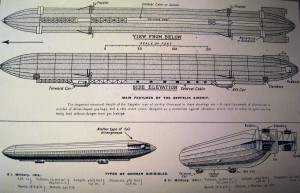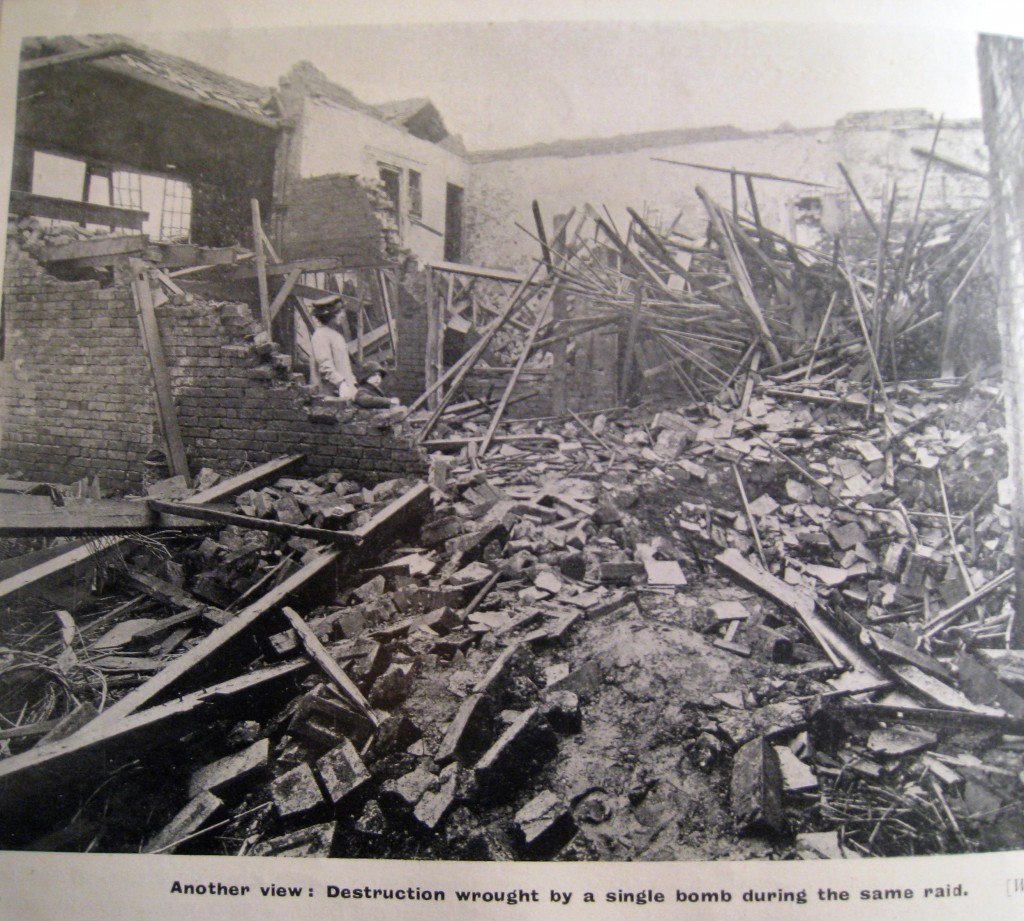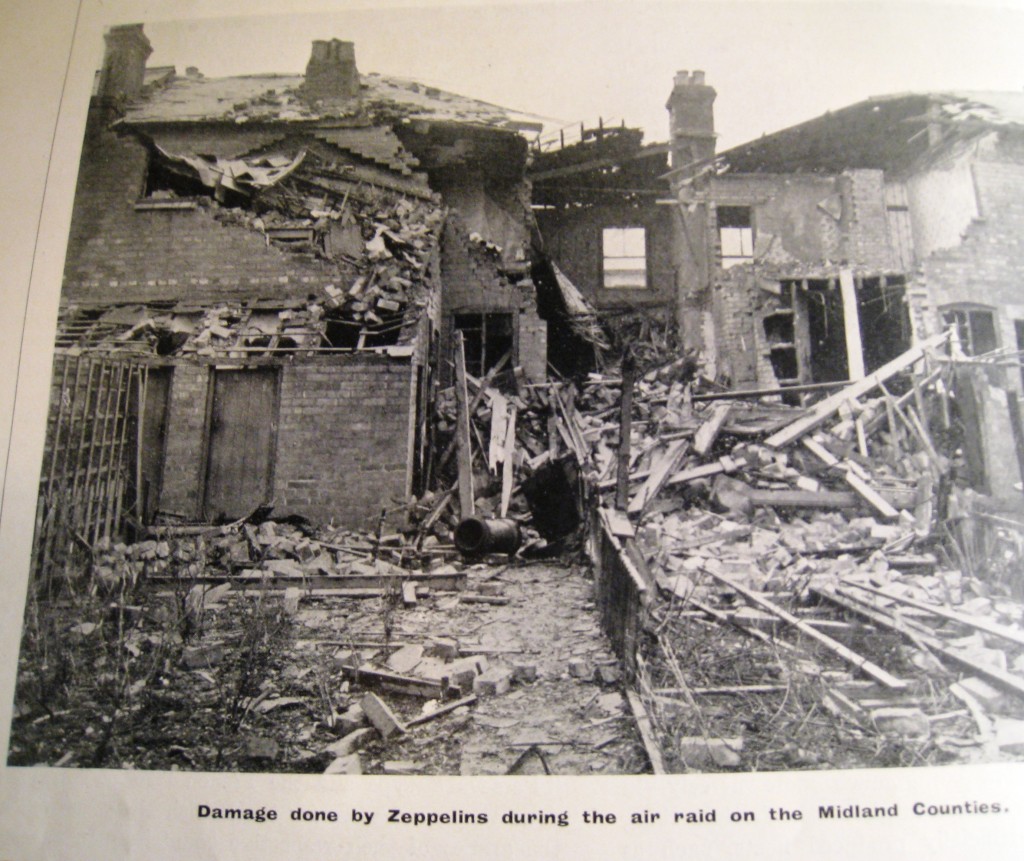 Please click on image to enlarge!
Please click on image to enlarge!
Here are some memories and experiences of local people who witnessed the Zeppelin raid of 1916 in the Rossendale area. I have reproduced them here, as they appeared in the Rossendale Free Press during the 1960s and 1970s. With thanks again to Rawtenstall Library and staff.
Dated 1/10/1966 R.F.P
Valley had its first air raid 50 years ago
Just fifty years ago this week Rossendale experienced its first air raid when German Zeppelins droned over the Valley and dropped a number of bombs. The writer was four at the time and has vivid memories of being wakened at what seemed the middle of the night, and taken out into the street to watch groups of people watching a silvery cigar shaped object sail awesomely but majestically over Cribden hill. A day or two later he recalls being taken for a walk to Ewood Bridge and seeing craters in the fields, as well as a distant view of the damage to Holcombe Church. There will be many more local people with memories of what was a frightening experience that was to be repeated on a far more devastating scale in the Second World War, though here again the Valley came off lightly. If readers have any stories or re-collections of the raid half a century ago we would be glad to hear of them.
8/10/1966 R.F.P
MEMORIES OF THE ZEPPELIN RAID
Sir, I was interested to read about the Zeppelin raid and I have many recollections of that day, 25th September 1916 I was 28 at the time.
It always ran in mind that it was 26 of September when it happened anyway it is near enough for me. It is quite right the course of the Zeppelin came in over Lumb as described by M.J. Jones and crossed over Seat Naze, Boltons Woods and Lea Bank, the home of Colonel Craven Hoyle, and then over Cloughfold Station and round Whinberry Hill to Bolton.
Now I can give you some more facts of its course. In the first place the Zeppelin was following a train on its way to Manchester, but when the train had got to Todmorden it stopped instead of veering left for Manchester. The Zeppelin kept straight on following the course described beforehand.
When it got to Seat Naze, the fire beater (stoker) at the “Rag Shop” that is what we called the Cotton Cellulose Works was just firing up the Boiler and the Zeppelin crew thought they would drop one (bomb) there. It fell just behind Colonel Craven Hoyle’s home. It was an aerial torpedo and was later blown up by soldiers from Bury Barracks.
They piled about ten tons of soil on the spot where it went into the ground, and when it went off, the soil was hurled about ten or fifteen feet in the air. Where Mr Lesley Talbot now lives in Newchurch Road, there was a gateway leading into a meadow. On the other side of the gate was a haystack and they laid the fuse from where the house now stands.
The next bomb fell at a point going up Hall Carr Road, about 30 yards from a farm on the Hillside. It is quite right to say you could put a horse and cart in the hole that it made. For a long time I had a piece of shrapnel that I found there.
The next bomb fell at Irwell Vale that resulted in another large hole as described by M.J. Jones. I might say that my brother Noel and I had both been discharged from the Army earlier in the year, Noel in May and myself early in June. Between then and September my Parents had bought a spinal carriage at Manchester. I remember quite well taking him over Newhall Hey Bridge and on to Edenfield and then down the footpath by the Church to where one of the bombs had been dropped.
One amusing memory of the raid comes to mind. A woman heard a lot of talking going on outside her house at the time and went to find out what was happening. She went back into the house where the others were in bed to tell them that the Zeppelins were over. Her uncle told her: “Ne’er heed up. we might as weel die in bed as ony wheer.”
Yours, etc
William T Capell
Dam Top Cottage, Cloughfold.
Nb Both Noel and William enlisted into the East Lancashire Regiment during WW1 but were discharged with sickness within a month of each other, (D. Drury)
17/8/1974
Zeppelin Raid
The reference in Jottings last week to the visit of a German Zeppelin to Rossendale during the First World War and the dropping of bombs has led a reader to ask if we can pinpoint the dates of this occurrence. Our files reveal that it happened during the night of Monday 25 September 1916 and that week’s issue carried a long account of the raid without disclosing where it had happened, for security reasons. The raid was merely described as having taken place in the North and the North Midlands. The newspaper story stated that the beats of the airship engines were first heard about ten minutes to midnight and within a few minutes it was clearly seen passing over the Valley.
A patrolling police constable saw it become almost stationary and within a few seconds the first bomb was dropped. Within a space of five to eight minutes the airship unloaded another 12 or 15 missiles before disappearing.
Also 17/8/1974
Explosions
Those Rossendale folk who had been wakened by the sound of the Zeppelins engines were quickly roused by the tremendous explosions that followed the dropping of its bombs. The concussion shook houses, rattling windows violently causing the structure to vibrate in some cases. As a result within a very short time the darkened streets were filled with hundreds of people but it was stated “there were no signs of panic or fear.” About 2.45 am it was reported officially that conditions were normal again and the electricity supply which had been cut off was restored. The next morning a tour of the district showed that within a radius of some three miles several bombs and some incendiaries had been dropped, in every case they had fallen onto soft earth. Three at least had failed to explode, those that did had left deep craters five or six yards across. One had fallen near to the end of a row of cottages in which every window had been shattered and doorways affected but there were no personal injuries of any kind. And so ended Rossendale’s experience of aerial attacks until over a quarter of a century later when there were some comparatively minor incidents during the Second World War though that time from aeroplanes.
The two Photographs reproduced here are from a publication circulated just after the Great War showing just what the destructive power of the Zeppelins bombs could do to residential properties.
Another picture from the same raid, note the woman and small child surveying the remnants of their home.

